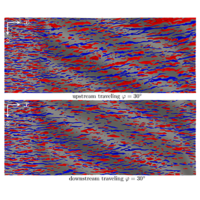当前位置:
X-MOL 学术
›
Phys. Rev. Fluids
›
论文详情
Our official English website, www.x-mol.net, welcomes your
feedback! (Note: you will need to create a separate account there.)
Drag reduction for swept flat plate flow
Physical Review Fluids ( IF 2.5 ) Pub Date : 2020-06-23 , DOI: 10.1103/physrevfluids.5.064611 Marian Albers , Wolfgang Schröder
Physical Review Fluids ( IF 2.5 ) Pub Date : 2020-06-23 , DOI: 10.1103/physrevfluids.5.064611 Marian Albers , Wolfgang Schröder

|
Drag reduction analyses for turbulent flow over a swept flat plate are conducted. To be more precise, large-eddy simulations of oblique traveling transversal surface waves in turbulent flat plate boundary layer flow at a momentum thickness based Reynolds number of are performed. For two parameter sets of the actuation parameters wavelength, period, and amplitude the angle between the wave propagation direction and the streamwise direction, i.e., the sweep angle , is varied. The goal is to investigate the susceptibility of drag reduction, net power saving, and turbulence to different sweep angles of the traveling waves. The extension of the technique of spanwise traveling transversal surface waves allows partially up- or downstream traveling waves, i.e., opposite to or in the main flow direction. For downstream traveling waves, the periodic spanwise shear is decreased and the reduction of the wall-shear stress is diminished. Nevertheless, strong decreases of the turbulent stress tensor components persist even for the largest sweep angle. For upstream traveling waves, there is an increase of the lowered friction drag reduction. However, the turbulence level in the outer flow is also higher since the pressure drag is increased such that the total drag reduction is massively lowered. Compared to a purely spanwise traveling wave, i.e., , the sweep angle leads to a much stronger phase dependence of the skin friction since the partially up- and downstream traveling waves induce also periodic fluctuations in the streamwise direction. A shift of energy towards larger scale motions is observed which is also reflected by an increase of the integral length scale close to the wall.
中文翻译:

减少阻力以实现平板流动
进行减阻分析,以分析扫掠平板上的湍流。更精确地说,湍流平板边界层中斜行进的横向表面波在基于动量厚度的雷诺数下的大涡模拟执行。对于驱动参数的两个参数集,波长,周期和振幅,波传播方向和流向之间的角度,即扫掠角,是多种多样的。目的是研究减阻,净功率节省和湍流对行波不同扫掠角的敏感性。跨展传播横向表面波技术的扩展允许部分上行或下行传播波,即与主流方向相反或沿主流方向。对于下游行波,周期性的展向剪切减小,壁剪应力的减小减小。然而,即使对于最大扫掠角,湍流应力张量分量的强烈减小仍然持续。对于上游行波,增加了降低的摩擦阻力减小量。但是,由于增加了压力阻力,使得总阻力减小量大大降低,因此外流中的湍流度也较高。,扫角 由于部分向上和向下的行波还会引起沿流向的周期性波动,因此导致皮肤摩擦的相位依赖性更强。观察到能量朝着较大尺度的运动转移,这也通过靠近壁的整体长度尺度的增加而反映出来。
更新日期:2020-06-24
中文翻译:

减少阻力以实现平板流动
进行减阻分析,以分析扫掠平板上的湍流。更精确地说,湍流平板边界层中斜行进的横向表面波在基于动量厚度的雷诺数下的大涡模拟执行。对于驱动参数的两个参数集,波长,周期和振幅,波传播方向和流向之间的角度,即扫掠角,是多种多样的。目的是研究减阻,净功率节省和湍流对行波不同扫掠角的敏感性。跨展传播横向表面波技术的扩展允许部分上行或下行传播波,即与主流方向相反或沿主流方向。对于下游行波,周期性的展向剪切减小,壁剪应力的减小减小。然而,即使对于最大扫掠角,湍流应力张量分量的强烈减小仍然持续。对于上游行波,增加了降低的摩擦阻力减小量。但是,由于增加了压力阻力,使得总阻力减小量大大降低,因此外流中的湍流度也较高。,扫角 由于部分向上和向下的行波还会引起沿流向的周期性波动,因此导致皮肤摩擦的相位依赖性更强。观察到能量朝着较大尺度的运动转移,这也通过靠近壁的整体长度尺度的增加而反映出来。









































 京公网安备 11010802027423号
京公网安备 11010802027423号